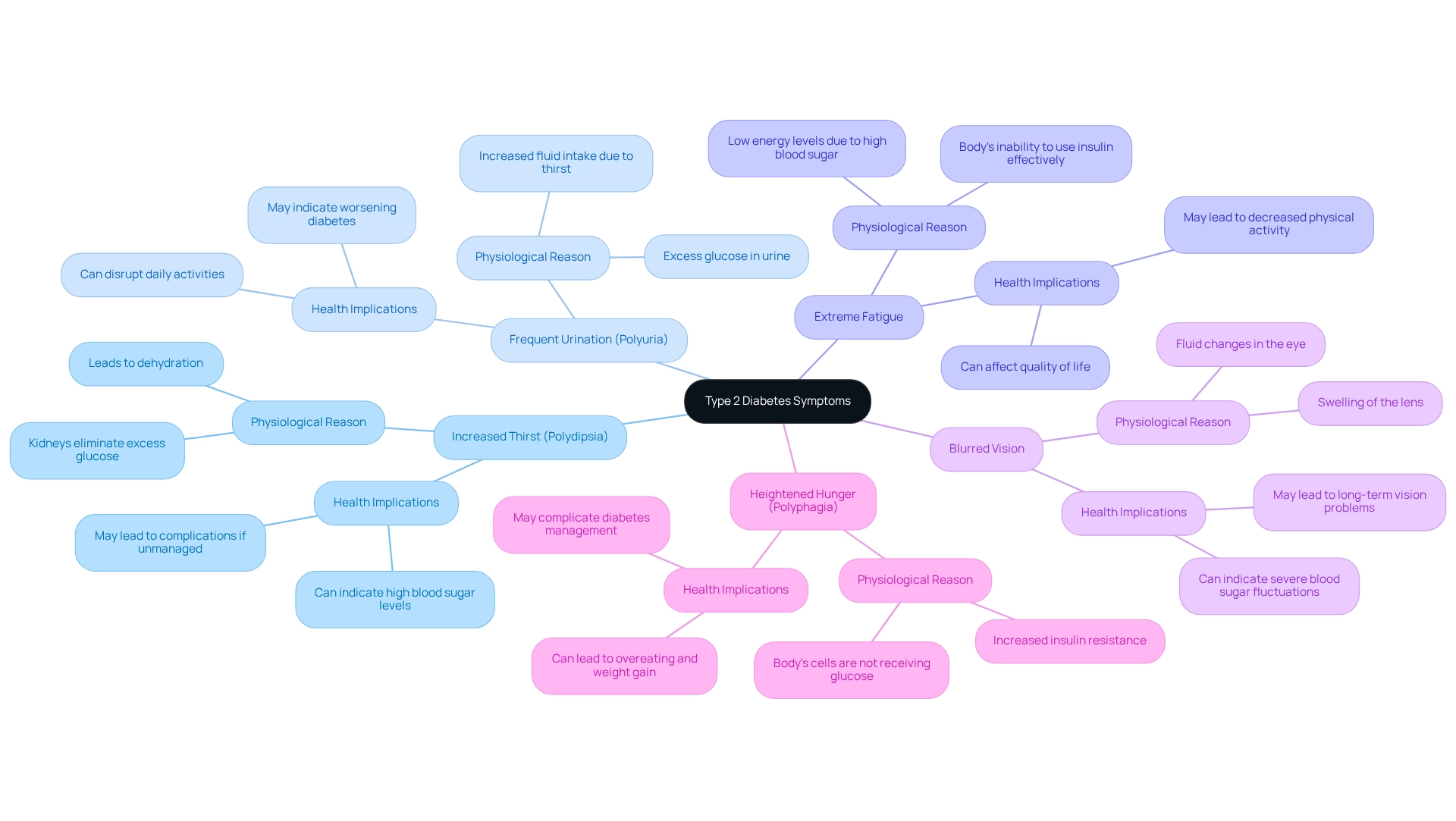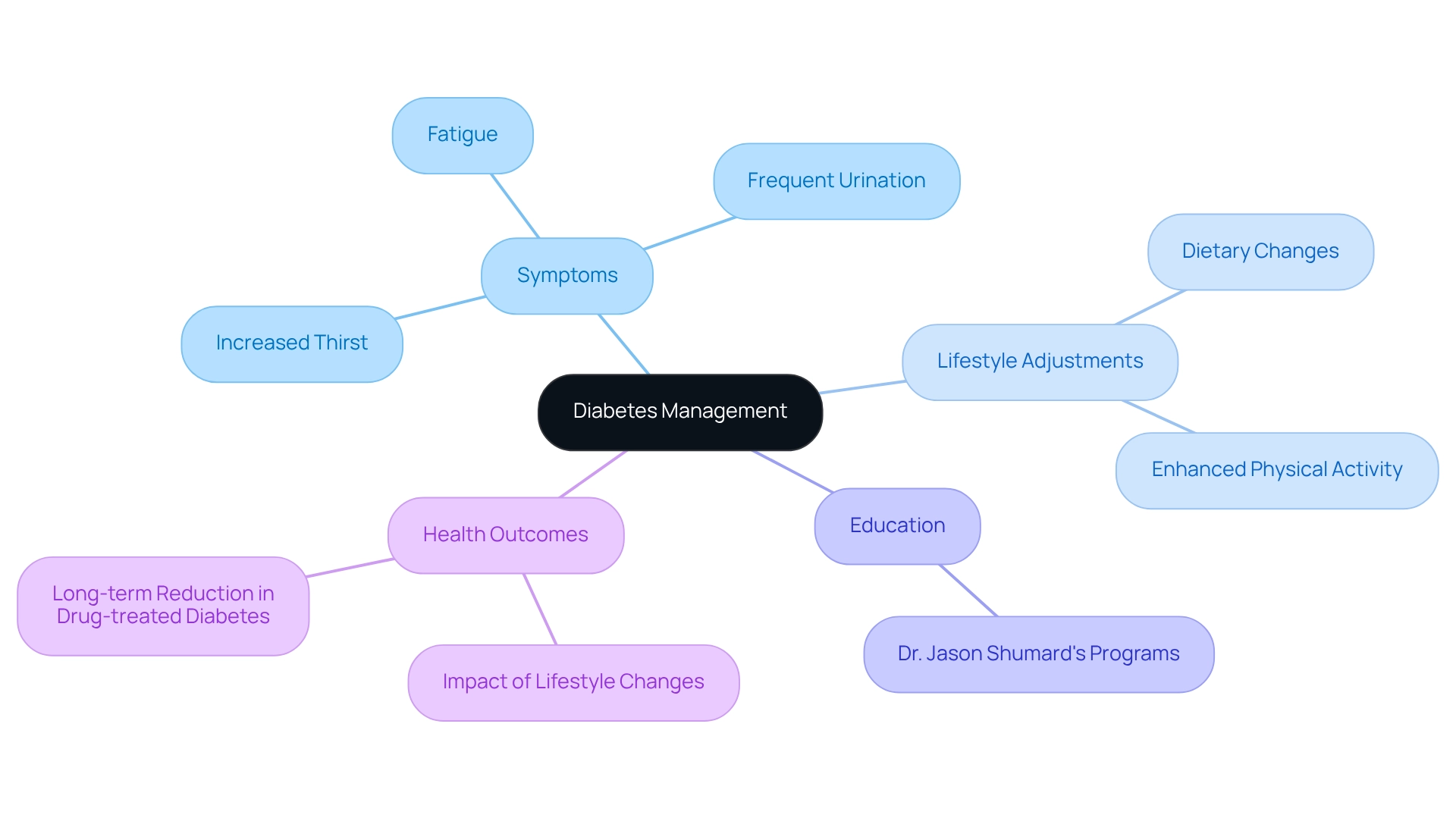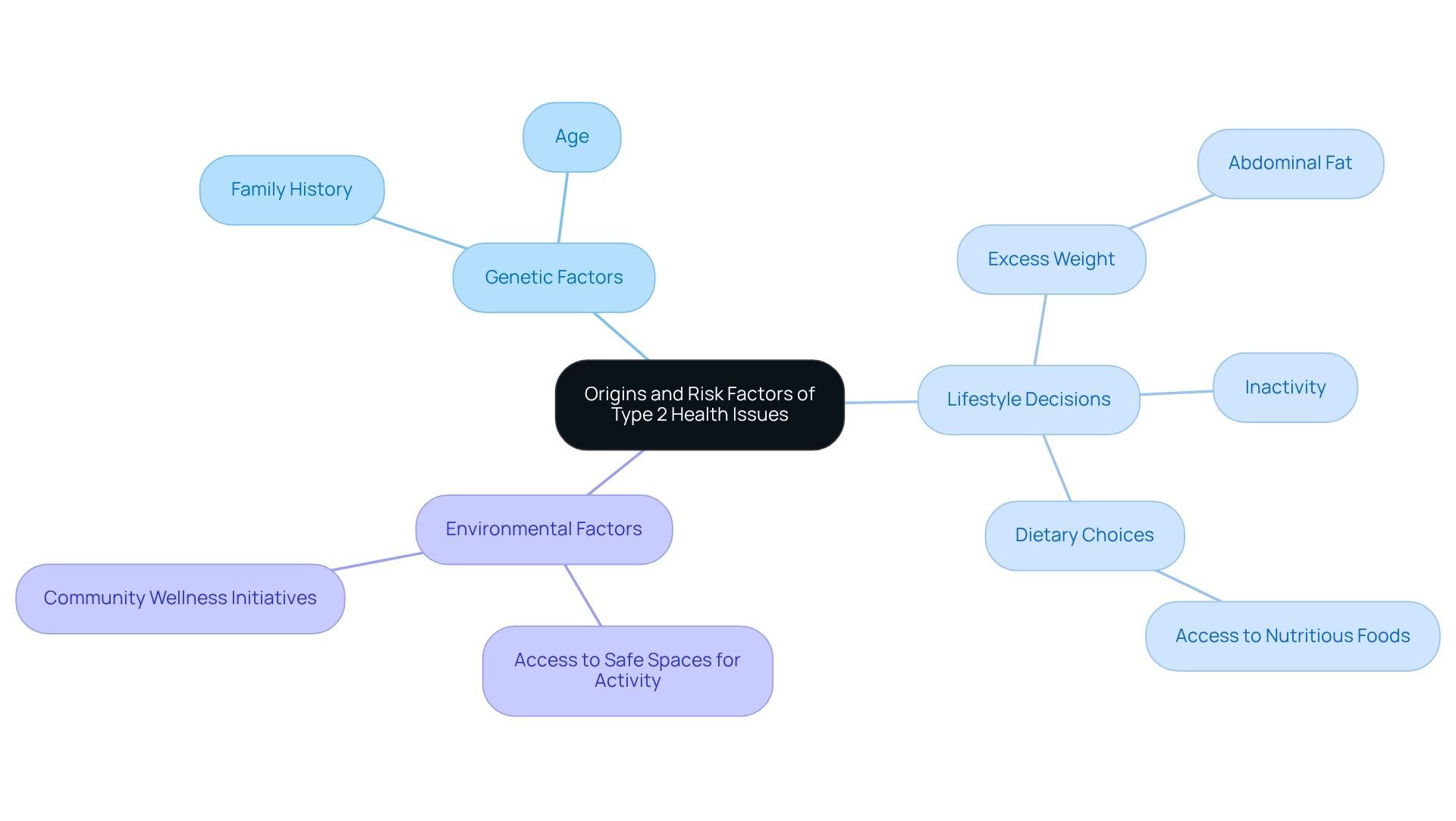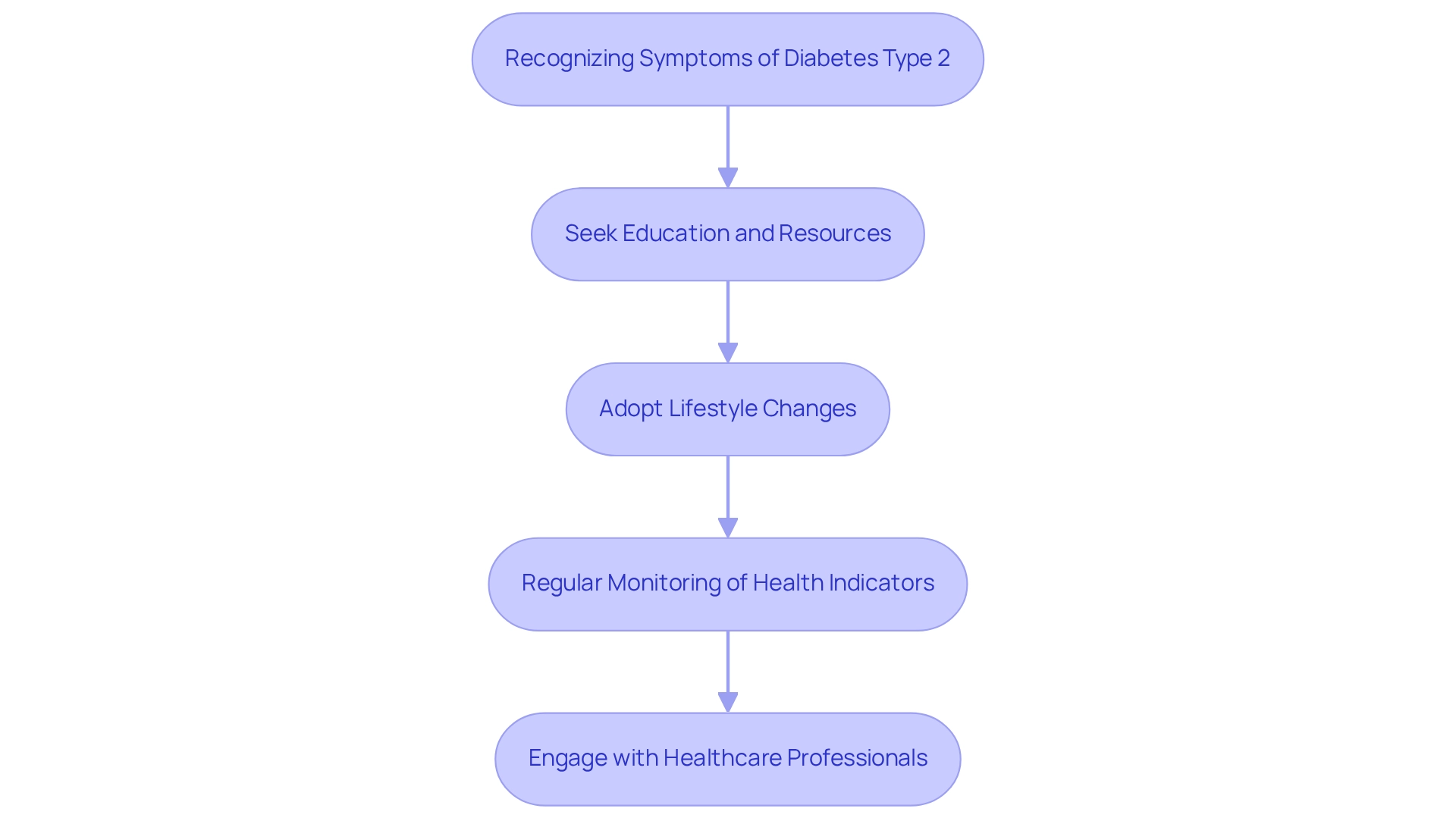Overview
If you’re experiencing increased thirst, frequent urination, extreme fatigue, blurred vision, or heightened hunger, it’s important to understand that these symptoms may indicate Type 2 diabetes. These signs arise from the body’s reduced ability to use insulin effectively and manage blood sugar levels. Recognizing these symptoms is crucial for early detection and management. Many patients find that timely lifestyle adjustments and access to educational resources can significantly improve their health outcomes.
It’s natural to feel overwhelmed, but you’re not alone in this journey. By acknowledging these struggles, you can take proactive steps toward a healthier future. Remember, making small changes can lead to significant improvements in your well-being and help prevent severe complications associated with this condition.
Consider reaching out for support, whether through healthcare professionals or community programs. The 30-Day Diabetes Reset program is designed to guide you through this process, providing the tools and encouragement you need. Together, we can navigate this path toward better health.
Introduction
In a world where type 2 diabetes is increasingly prevalent, understanding its symptoms is more critical than ever. Have you ever felt an unquenchable thirst, experienced frequent trips to the bathroom, or noticed fatigue creeping in? These signs can often serve as the body’s alarm system, signaling the need for immediate lifestyle adjustments. It’s important to recognize that as communities grapple with rising obesity rates and sedentary habits, the importance of acknowledging these indicators cannot be overstated.
In San Marcos, CA, many individuals are discovering a holistic approach to health—incorporating outdoor activities, balanced diets, and community support—that offers a pathway to better management of diabetes. By exploring the origins, risk factors, and the necessity for early detection, individuals can empower themselves to take proactive steps toward improved health outcomes and a more vibrant life. Together, we can navigate these challenges and embrace a healthier future.
Define Type 2 Diabetes Symptoms
Type 2 diabetes signs can manifest differently for each individual, but there are several common indicators to be aware of. These include:
- Increased thirst (polydipsia)
- Frequent urination (polyuria)
- Extreme fatigue
- Blurred vision
- Heightened hunger (polyphagia)
Such signs arise from the body’s reduced ability to use insulin effectively, which leads to elevated blood sugar levels. For instance, excessive thirst and urination occur as the kidneys work hard to eliminate excess glucose, resulting in dehydration.
In San Marcos, CA, adopting a holistic lifestyle can be vital in addressing these challenges. Engaging in regular outdoor activities, such as hiking or walking in local parks, not only helps improve insulin sensitivity but also boosts overall well-being. A balanced diet filled with local produce, like avocados and berries, can support blood sugar regulation. Community wellness initiatives, including educational sessions on blood sugar management and support groups, provide additional resources and assistance, empowering individuals to take proactive steps in their health journey.
It’s important to recognize that a significant number of individuals with type 2 diabetes experience these signs, highlighting the urgent need for awareness and timely action. In fact, studies reveal that approximately 73,000 lower-limb amputations were performed in diabetics aged 20 and older, underscoring the serious complications that can arise if symptoms go unrecognized and unmanaged.
Many patients find that living with this condition brings a heightened risk of severe health issues, including cardiovascular disease, kidney failure, and mental health disorders. This reinforces the necessity for effective management strategies and preventive measures. By identifying early indicators of the condition, patients can take proactive steps toward improved health outcomes.
As we look ahead to 2025, ongoing research continues to shed light on the prevalence and impact of type 2 diabetes, emphasizing the importance of reliable sources and peer-reviewed studies for health information. Understanding these signs not only aids in early identification but also empowers individuals to manage their health journey, especially with tailored support from healthcare experts like Dr. Jason Shumard.
Contextualize Symptoms in Diabetes Management
Identifying indicators is vital for successful diabetes management. Increased thirst, fatigue, and frequent urination are what’s the symptoms of diabetes type 2 and can signal the need for immediate lifestyle adjustments, including dietary changes and enhanced physical activity. For instance, many patients find that closely monitoring their carbohydrate intake when experiencing frequent urination can significantly help in managing blood sugar levels. Educational programs, like those offered by Dr. Jason Shumard, play a crucial role in empowering individuals with knowledge about what’s the symptoms of diabetes type 2. This understanding enables them to take proactive steps on their health journey, fostering informed decision-making regarding their treatment plans.
It’s important to recognize that changes in daily habits can greatly enhance health outcomes. A recent study emphasized that moderate weight loss achieved through one year of behavioral guidance in primary healthcare led to a long-term decrease in the occurrence of medication-treated type 2 diabetes. This highlights the significance of identifying and addressing what’s the symptoms of diabetes type 2 early on. By adopting changes in daily habits based on recognizing these issues, individuals can effectively manage their condition and improve their overall health. Remember, every small step counts on this journey toward better health.
Examine Origins and Risk Factors of Symptoms
The origins of type 2 health issues arise from a complex interaction of genetic factors and lifestyle decisions. It’s important to recognize that excess weight, especially around the abdomen, is a significant risk factor, as it leads to insulin resistance, a key cause of diabetes-related issues. Current statistics indicate that nearly 42% of adults in the U.S. are classified as obese, highlighting the urgent need for effective management strategies. Additionally, inactive behavior further intensifies this risk; people who participate in little physical activity are more prone to developing insulin resistance and may experience what’s the symptoms of diabetes type 2.
In San Marcos, CA, individuals can adopt holistic approaches to combat these risks. Many patients find that embracing the area’s outdoor lifestyle through regular exercise in scenic parks and trails can significantly improve insulin sensitivity and help control weight. Participating in community wellness initiatives offers extra assistance and resources designed for effectively managing blood sugar levels.
Age and family history are also critical determinants. Individuals older than 45 or those with a family background of the illness encounter an increased risk of developing the condition. Environmental factors, including access to nutritious foods and safe spaces for physical activity, significantly influence these risks. For example, communities with restricted access to nutritious food choices frequently experience elevated rates of obesity and other health issues.
Research findings highlight the significance of tackling both genetic and lifestyle factors in the prevention of this condition. Case studies have demonstrated that individuals who embrace healthier lifestyles—such as enhanced diet and greater physical activity—can significantly lower their risk of what’s the symptoms of diabetes type 2. Furthermore, specialist perspectives emphasize that the two primary factors contributing to type 2 are excess weight, particularly around the abdomen, and inadequate physical activity. Dr. Jason Shumard states, “The two primary factors contributing to type 2 are carrying excess weight — particularly in your abdomen — and insufficient physical activity.”
By understanding these risk factors and incorporating personalized functional medicine approaches, individuals can take proactive steps toward prevention and early intervention, ultimately improving their health outcomes. Additionally, participating in local farmers’ markets can provide access to fresh produce like avocados, berries, and leafy greens, which are beneficial for a diabetes-friendly diet. Stress management methods, such as yoga and meditation sessions offered in the community, can also play an essential part in overall health management.
The Importance of Early Detection and Management
Recognizing what’s the symptoms of diabetes type 2 is vital for effective management and preventing severe complications. It’s important to acknowledge the struggles individuals face; identifying and addressing what’s the symptoms of diabetes type 2 promptly can empower them to make lifestyle changes that may halt the disease’s progression. For example, programs like Dr. Shumard’s 30-Day Diabetes Reset provide patients with essential tools and knowledge to manage their condition effectively. By focusing on education and empowerment, individuals can enhance their quality of life and reduce reliance on traditional medical treatments.
Statistics show that the crude rate of diabetes-related deaths was 120.3 per 100,000 people in 2021, highlighting the urgent need for early intervention. Preventive strategies, such as regular physical activity and nutritious eating, are crucial in managing the risk of this condition. Many patients find that adopting these lifestyle changes significantly lowers their chances of developing type 2 diabetes, illustrating the power of preventive healthcare.
Moreover, early intervention can lead to remarkable improvements in health outcomes. Consistent monitoring of indicators and blood sugar levels, along with conversations with healthcare professionals, is essential for understanding what’s the symptoms of diabetes type 2 and fosters a proactive approach to managing the condition. This not only helps in reversing symptoms but also empowers individuals to take charge of their health journey, ultimately leading to better long-term results. Remember, you are not alone in this journey; support is available, and taking that first step can make all the difference.
Conclusion
Recognizing the symptoms of type 2 diabetes is crucial in managing this increasingly prevalent condition. Common indicators such as increased thirst, frequent urination, fatigue, and blurred vision signal a need for immediate lifestyle adjustments. It’s important to understand these symptoms and their origins; by doing so, individuals can take proactive steps to enhance their health outcomes. Engaging in outdoor activities, maintaining a balanced diet, and participating in community wellness programs are vital strategies that can significantly improve insulin sensitivity and overall well-being.
Many patients find that the interplay of genetic predisposition and lifestyle choices highlights the importance of early detection and intervention. With nearly 42% of adults in the U.S. classified as obese, addressing risk factors such as poor diet and sedentary behavior is critical. Educational initiatives, like those led by healthcare professionals, empower individuals to make informed decisions regarding their treatment plans. The effectiveness of lifestyle modifications in reducing diabetes symptoms cannot be overstated. Research demonstrates the long-term benefits of weight loss and increased physical activity, which can transform lives.
Ultimately, embracing a holistic approach to health can pave the way for a more vibrant life, especially in communities like San Marcos, CA. By fostering awareness and support, individuals can navigate the challenges of diabetes and work towards a healthier future. Prioritizing early detection, education, and proactive lifestyle changes is essential for managing type 2 diabetes effectively and reducing the risk of serious complications. Together, these efforts can transform lives and promote a culture of health and wellness.
Key Tips for Managing Type 2 Diabetes:
- Engage in regular physical activity.
- Maintain a balanced diet rich in whole foods.
- Participate in community wellness programs for support.
Remember, you are not alone on this journey. Embracing these changes can lead to a healthier, more fulfilling life.
Frequently Asked Questions
What are the common symptoms of Type 2 diabetes?
Common symptoms of Type 2 diabetes include increased thirst (polydipsia), frequent urination (polyuria), extreme fatigue, blurred vision, and heightened hunger (polyphagia).
Why do these symptoms occur in Type 2 diabetes?
These symptoms arise from the body’s reduced ability to use insulin effectively, leading to elevated blood sugar levels. Excessive thirst and urination occur as the kidneys work hard to eliminate excess glucose, resulting in dehydration.
How can lifestyle changes help manage Type 2 diabetes symptoms?
Adopting a holistic lifestyle, such as engaging in regular outdoor activities and maintaining a balanced diet filled with local produce, can improve insulin sensitivity and overall well-being.
What role do community wellness initiatives play in managing Type 2 diabetes?
Community wellness initiatives, such as educational sessions on blood sugar management and support groups, provide resources and assistance, empowering individuals to take proactive steps in their health journey.
What are the potential complications of unmanaged Type 2 diabetes?
Unmanaged Type 2 diabetes can lead to severe health issues, including cardiovascular disease, kidney failure, and mental health disorders. It can also result in serious complications, such as lower-limb amputations.
Why is early identification of Type 2 diabetes symptoms important?
Early identification of symptoms is crucial as it allows patients to take proactive steps toward improved health outcomes and reduces the risk of serious complications.
What is the significance of ongoing research on Type 2 diabetes?
Ongoing research continues to highlight the prevalence and impact of Type 2 diabetes, emphasizing the importance of reliable sources and peer-reviewed studies for health information.



